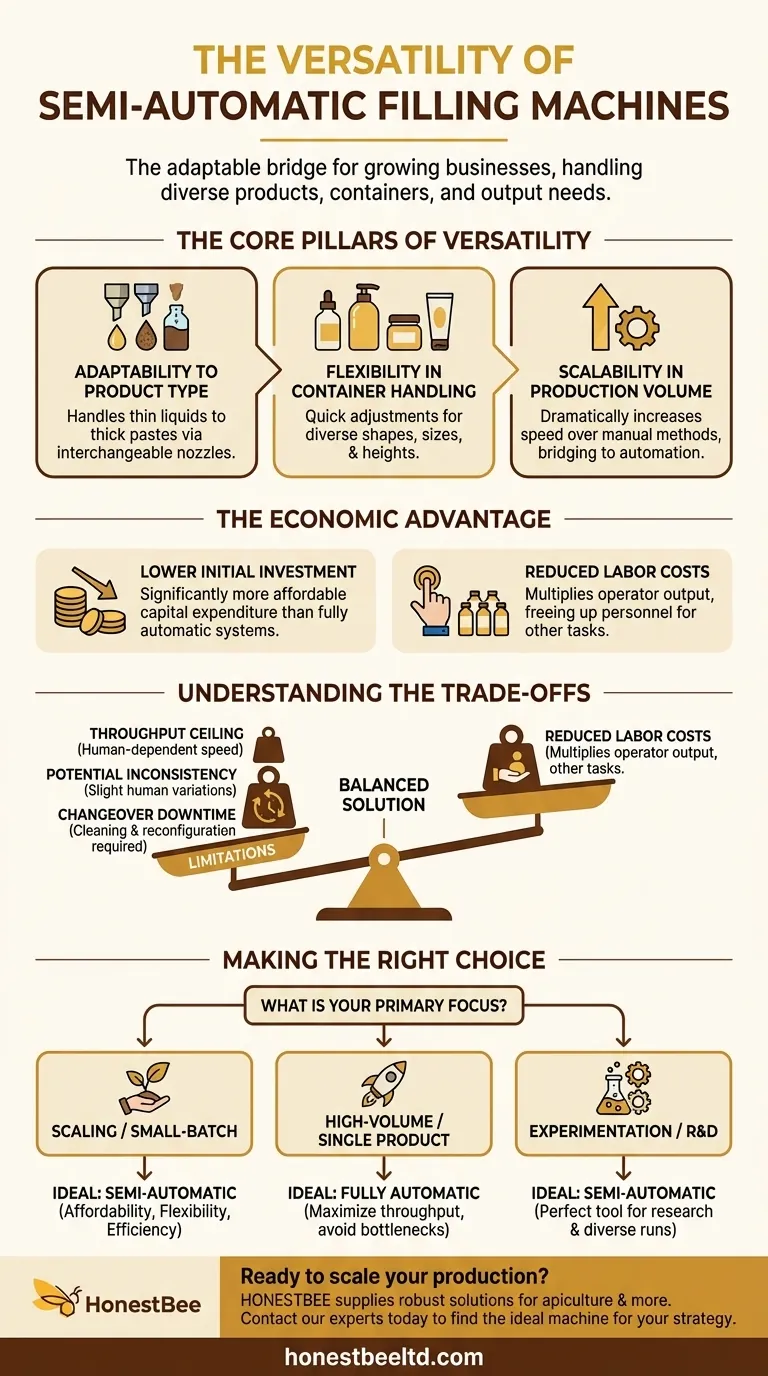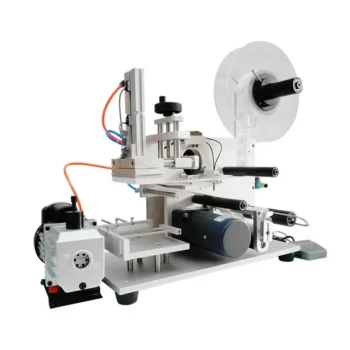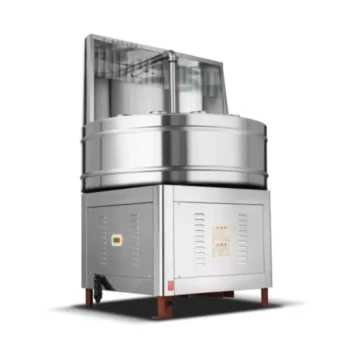At their core, semi-automatic filling machines are versatile because they are designed for adaptability. They can be quickly configured to handle a wide range of product viscosities—from thin liquids to thick pastes—and accommodate many different container shapes and sizes, making them a flexible solution for growing businesses.
The true versatility of a semi-automatic filler lies not just in its mechanical flexibility, but in its strategic position as a bridge. It allows businesses to scale up from manual processes and increase efficiency without committing to the high cost and rigidity of a fully automated system.

The Core Pillars of Versatility
A semi-automatic filler's value comes from its ability to adapt to the three primary variables of a production environment: the product, the container, and the required output.
Adaptability to Product Type
The most significant feature is the machine's capacity to handle products with different characteristics. This is often achieved through interchangeable nozzles or pump systems.
Whether your product is a free-flowing liquid, a viscous spread like honey, or a dense paste, the machine can be configured for an accurate and consistent fill.
Flexibility in Container Handling
Unlike fully automatic lines that often require significant re-tooling, semi-automatic systems are built for quick adjustments.
An operator can easily change guides or settings to switch between different bottle sizes, jar shapes, or container heights. This makes them ideal for businesses with a diverse product portfolio.
Scalability in Production Volume
These machines occupy a critical middle ground in production capacity. They dramatically increase the speed and consistency over manual, hand-filling methods.
While they do not match the high throughput of a fully automatic line, they provide the efficiency boost needed for small to medium-sized operations to grow.
The Economic Advantage: Versatility in Budget
Beyond the physical machine, versatility extends to how it fits within a company's financial and operational strategy.
Lower Initial Investment
The most compelling economic benefit is the lower capital expenditure. Semi-automatic fillers are significantly less expensive than their fully automatic counterparts.
This accessibility allows smaller companies or startups to professionalize their packaging process without a prohibitive upfront cost.
Reduced Labor Costs vs. Manual Filling
While an operator is still required, the machine automates the repetitive and time-consuming task of measuring and dispensing the product.
This single change can multiply the output of one employee, effectively reducing labor cost per unit and freeing up personnel for other valuable tasks.
Understanding the Trade-offs
True versatility requires understanding a machine's limitations. A semi-automatic filler is a balanced solution, and that balance comes with specific trade-offs.
Throughput Limitations
The primary trade-off is speed. A semi-automatic machine is dependent on an operator to place the container and initiate the fill cycle.
This human element creates a ceiling on production speed. For very large-scale operations, it will inevitably become a bottleneck.
The Human Element
Because an operator is part of the process, there is a greater potential for slight inconsistencies in container placement or cycle timing compared to a fully robotic system.
This is rarely an issue for most applications but is a factor to consider for industries requiring extreme precision across massive runs.
Changeover Time and Cleanup
While they are adaptable, switching between fundamentally different products (e.g., from a thin liquid to a thick paste) requires cleaning and re-configuration.
This downtime is a necessary part of the process and must be factored into production scheduling.
Making the Right Choice for Your Operation
Selecting the right equipment depends entirely on your specific goals. Analyze your operational needs to determine if a semi-automatic filler is the correct strategic fit.
- If your primary focus is starting or scaling a small-batch operation: The balance of affordability, flexibility, and improved efficiency makes a semi-automatic machine the ideal choice.
- If your primary focus is maximizing throughput for a single, high-volume product: You should invest in a fully automatic system designed for that specific task to avoid production bottlenecks.
- If your primary focus is product experimentation with diverse containers and formulations: The easy adaptability of a semi-automatic filler makes it a perfect tool for research, development, or artisanal production runs.
Ultimately, choosing the right filling machine is about aligning the technology with your business strategy and growth plan.
Summary Table:
| Key Feature | Benefit | Ideal For |
|---|---|---|
| Adaptable Product Handling | Handles liquids, pastes, and thick creams with simple adjustments. | Businesses with diverse product lines. |
| Flexible Container Support | Quick changeover between various bottle and jar sizes. | Operations with frequent packaging changes. |
| Scalable Production | Bridges the gap between manual labor and full automation. | Small to medium businesses scaling up. |
| Lower Initial Investment | More affordable than fully automatic systems. | Startups and companies with budget constraints. |
Ready to scale your production with the right equipment?
At HONESTBEE, we supply commercial apiaries and beekeeping equipment distributors with robust, semi-automatic filling solutions perfect for handling everything from thin honey to thick waxes. Our machines offer the flexibility and affordability your growing operation needs.
Contact our experts today to find the ideal filling machine for your business strategy and product line.
Visual Guide

Related Products
- Pneumatic Double Nozzle Honey Filling Bottling Packaging Machine
- Pneumatic Paste Filling Machine Bottling Packaging Machine Single Nozzle
- Semi Automatic Round Bottle Labeling Machine
- Automated Rotary Bottle Unscrambler for Honey Production Line
- HONESTBEE Professional Benchtop Pneumatic Bottle Capping Machine Capper
People Also Ask
- What are the main differences between automated and manual honey filling? Scale Your Bottling Operation
- What are the benefits of using a honey filler? Boost Bottling Speed, Consistency & Brand Appeal
- What are the key features of a honey packaging machine? Essential for Quality & Efficiency
- What are the different types of honey fillers? A Guide to Manual, Semi & Fully-Automatic Fillers
- What are the types of bottling machines used for honey? Find the Right Filler for Your Scale



















